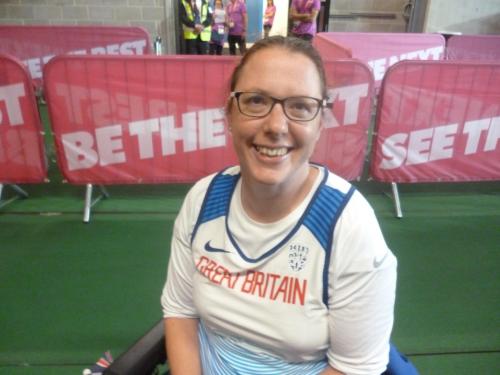 Gemme Prescott throwing Club Throw, photo by Stuart Weir
Gemme Prescott throwing Club Throw, photo by Stuart Weir
I met Stuart Weir in Beijing at World Champs. We began chatting and I asked him to write. Soon after that, he was off to Doha for the IPC World Athletic Games. Stuart is covering the first day of the IPC World Disability Games in London. I still do not understand why Americans do not appreciate the IPC Games. It may be due to US TV, but, at RunBlogRun we want to show you the joy of mastering athletic talents, no matter what your challenges. Athletics is spirit, focus and technique. Celebrate movement.
The IPC World Disability Games got underway tonight with club throw, the only athletic discipline which is unique to para-athletics. (The IPC throwing events are shot, discus, javelin and club throw). Club throw is an unfamiliar event to those familiar only with non-disabled athletics. But why is there any more kudos in throwing a hammer, than a club?
 Gemma Prescott, photo by Stuart Weir
Gemma Prescott, photo by Stuart Weir
The object of club throw is simply to throw the club as far as possible The event was introduced for both men and women at the first Summer Paralympic Games in 1960, dropped from the women’s programme from the 1992 Games but reinstated for London 2012. The club looks like a small baseball bat and weighs a minimum of 397 grams (14.0 oz). The event is contested by in the F32* and F51* classes.
Throwers can be called for a foul if the club does not land in the landing area or if their butt does not remain in contact with the cushion throughout the throw.
The F32 was won by Mounia Gasmi of Algeria, who finally got gold after finishing second at five other championships. Gemma Prescott who won bronze in the F32 said afterwards: “I love being in the stadium. It felt good tonight. I felt relaxed and really enjoyed being out there”.
Gemma was first to throw which causes some problems “like maintaining warm-up in the call room and being ready to throw as soon as you go out as you can’t do it on the field”. Then having finished you watch everyone else. Gemma continued: “All you can do is sit and wait. It’s not a nice position to be in. I don’t know why they did not reverse the order for the second series. Usually they go 8 to 1 so that if you are still in a medal position you know you have it when you throw. This was very different because I threw first and had quite a long wait for another seven people to throw”.
The F51 competition which took place simultaneously at opposite corners of the same end of the stadium was won by Zoia Ovsii of Ukraine, who called it: “an unbelievable feeling to win the world title. I am glad I made my teammates and my coach happy; my family does not follow this competition. I think I will celebrate this title back home in Ukraine. There is still some work to be done here as I am also in the discus.” Defending champion, Jo Butterfield (GB) could only finish fourth, punished out of the medals by the last competitor, Rachel Morrison.
The competitions lasted over two hours but held my attention. The necessity for competitors to take three throws in a row – because of the time it takes to get strapped into position – means that you lose some of the cut and thrust of alternating throws, but one recognizes that it is the only way to do it. However, I agree with Gemma that the organizers missed a trick by not reversing the order.



















